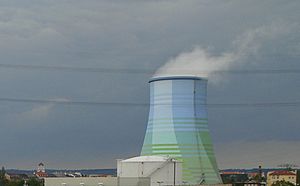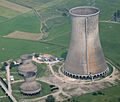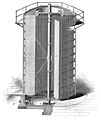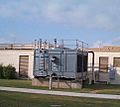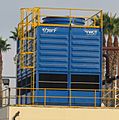Cooling tower facts for kids
Cooling towers are tall structures that help big factories and power plants get rid of extra heat. They release this heat into the air around us. Imagine a giant fan that cools things down!
Some cooling towers work by letting water evaporate, which cools down the air nearby. This is like how sweating cools your body. Other cooling towers use only air to cool things, similar to a big radiator.
You can often see cooling towers at places like oil refineries, chemical factories, and especially power stations. They are very common at nuclear power plants. It's important to know that in a nuclear power plant, the cooling tower is completely separate from the nuclear part. The steam you see coming out of these towers is just water vapor, like clouds, and it is not radioactive or harmful. In fact, the cooling tower is often the tallest and most noticeable building at a nuclear power plant.
Contents
How Do Cooling Towers Work?
Cooling towers have a simple but clever job: they remove unwanted heat. Think of it like a giant air conditioner for industrial places.
Wet Cooling Towers
Many cooling towers use water to cool things down. This is called "wet cooling." Hot water from a factory or power plant is sprayed inside the tower. As the water falls, it meets cooler air moving upwards. A small part of the water turns into vapor (evaporates). This evaporation takes a lot of heat away, cooling the remaining water. The cooled water is then sent back to be used again.
Dry Cooling Towers
Some cooling towers use only air to cool things. This is called "dry cooling." Instead of evaporating water, these towers have large fins, like a car radiator. Hot liquid flows through pipes with these fins. Air is blown over the fins, which takes the heat away. Dry cooling towers don't use much water, which can be good in dry places. However, they don't cool as much as wet towers.
Where Are Cooling Towers Used?
Cooling towers are essential for many industries that produce a lot of heat.
Power Stations
One of the main places you'll see cooling towers is at power stations. Whether they burn coal, gas, or use nuclear energy, power plants create a lot of heat when they make electricity. Cooling towers help them release this heat safely into the atmosphere. This makes the power plant run more efficiently.
Factories and Refineries
Many other large industrial sites also use cooling towers. Oil refineries, chemical plants, and even some large air conditioning systems in big buildings use them. They help cool down machinery and processes that generate heat, preventing them from overheating.
Types of Cooling Towers
Cooling towers come in different shapes and sizes, depending on how they move air and how they are built.
Natural Draft Towers
These are the very tall, often hourglass-shaped towers you might see. They don't use big fans. Instead, they rely on natural airflow. Hot, moist air inside the tower is lighter than the cooler, drier air outside. This difference in weight makes the hot air rise, pulling in cooler air from the bottom. This creates a natural draft, like a chimney.
Mechanical Draft Towers
These towers use large fans to push or pull air through the tower. They can be shorter and are often found in groups.
- Induced Draft: The fan is at the top, pulling air up through the tower.
- Forced Draft: The fan is at the bottom, pushing air up through the tower.
Mechanical draft towers are more common for smaller industrial uses or where space is limited.
Why Are Cooling Towers Important?
Cooling towers play a vital role in our modern world.
Protecting Water Resources
Before cooling towers, many factories and power plants would release hot water directly into rivers or lakes. This "thermal pollution" could harm fish and other aquatic life. Cooling towers help prevent this by releasing heat into the air instead of water.
Energy Efficiency
By efficiently removing heat, cooling towers help industrial processes and power plants run better. This means they can produce more electricity or products with less waste, saving energy and resources.
Images for kids
See also
 In Spanish: Torre de refrigeración para niños
In Spanish: Torre de refrigeración para niños



